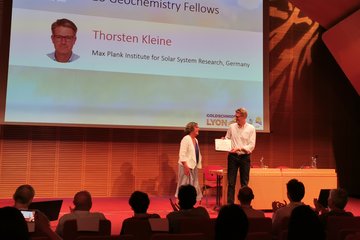Alle Typen
1.
Zeitschriftenartikel
Pulsations of the polar cusp aurora at Saturn. Journal Geophysical Research 121, S. 11952 - 11963 (2016)
2.
Zeitschriftenartikel
Statistical analysis and multi-instrument overview of the quasi-periodic 1-hour pulsations in Saturn's outer magnetosphere. Icarus 271, S. 1 - 18 (2016)
3.
Zeitschriftenartikel
Quasi-periodic injections of relativistic electrons in Saturns outer magnetosphere. Icarus 263, S. 101 - 116 (2016)
4.
Zeitschriftenartikel
The far-ultraviolet main auroral emission at Jupiter - Part 1: Dawn-dusk brightness asymmetries. Annales Geophysicae 33, S. 1203 - 1209 (2015)
5.
Zeitschriftenartikel
The far-ultraviolet main auroral emission at Jupiter - Part 2: Vertical emission profile. Annales Geophysicae 33, S. 1211 - 1219 (2015)
6.
Zeitschriftenartikel
Transient small-scale structure in the main auroral emission at Jupiter. Journal Geophysical Research 119, S. 9931 - 9938 (2014)
7.
Buchkapitel
Dawn-Dusk Asymmetries in Jupiter's Magnetosphere. In: Dawn-Dusk Asymmetries in Planetary Plasma Environments, S. 309 - 322 (Hg. Haaland, S.; Runov, A.; Forsyth, C.). Wiley, Hoboken (2017)
8.
Vortrag
Planetary period modulations of reconnection events in Saturn’s magnetotail. Magnetospheres of the Outer Planets Conference , Boulder, Colorado, USA (2018)
9.
Vortrag
Juno, Hubble and James Webb observing Jupiters aurora. Magnetospheres of the Outer Planets conference (MOP), Uppsala, Sweden (2017)
10.
Vortrag
Pulsations in Saturns magnetosphere. Magnetospheres of the Outer planets conference (MOP), Uppsala, Sweden (2017)
11.
Vortrag
Multi-instrument overview of the 1-hour pulsations in Saturn's magnetosphere. DPG Frühjahrstagung 2017, Bremen (2017)
12.
Vortrag
Multi-instrument overview of the 1-hour pulsations in Saturn's magnetosphere and auroral emissions. European Geosciences Union General Assembly, Vienna, Austria (2016)
13.
Vortrag
Multi-instrument overview of the 1-hour pulsations in Saturn's magnetosphere and auroral emissions. Cassini MAPS meeting, Ann Arbor, USA (2016)
14.
Vortrag
Statistical analysis of the quasi-periodic relativistic electron injections in the Saturn's magnetosphere. Cassini PSG meeting #65, Rome, Italy (2015)
15.
Vortrag
Statistical analysis and multi-instrument overview of the quasi-periodic 1-hour pulsations in the Saturn's outer magnetosphere. Magnetospheres of the Outer Planets, Atlanta, Georgia, USA (2015)
16.
Vortrag
Global Flow Patterns in the Jovian Magnetosphere: Galileo/EPD and Galileo/PLS measurements. European Planetary Science Congress EPSC, Cascais, Portugal (2014)
17.
Vortrag
Transient small-scale structure in the main auroral emission at Jupiter. European Planetary Science Congress EPSC, Cascais, Portugal (2014)
18.
Vortrag
Quasi-Periodic injections of relativistic electrons in Saturn's magnetosphere. European Planetary Science Congress EPSC, Cascais, Portugal (2014)
19.
Poster
Quasi-periodic latitudinal shift of Saturn's main auroral emission. American Geophysical Union, Fall Meeting 2017, New Orleans, Louisiana (2018)
20.
Poster
Quasi-periodic latitudinal shift of Saturn's main auroral emissions. AGU Fall Meeting, New Orleans, USA (2017)











